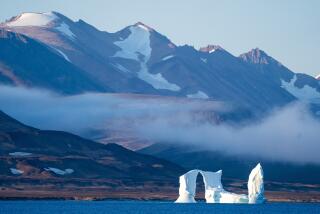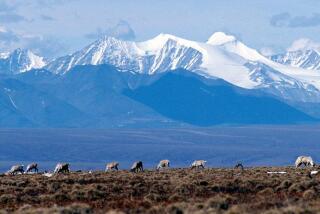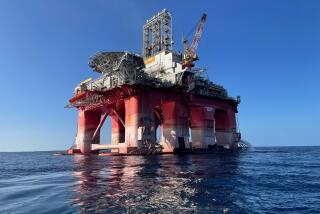Heavy sea ice could mean slight delay in offshore Arctic drilling
SEATTLE -- The heaviest polar ice in more than a decade is clinging to the northern coast of Alaska and could postpone the commencement of offshore oil drilling in the Arctic until the beginning of August — a delay of up to two weeks, Shell Alaska officials said Friday.
Unveiling the newly refurbished ice-class drilling rig that is poised to commence plumbing two exploratory wells this summer in the Beaufort Sea, Shell executives said the unusually robust sea ice would further narrow what already is a tight window for operations in a $4-billion program designed to measure the extent of what could be the United States’ most important new inventory of oil and gas.
Shell has pledged to end its first season of exploratory drilling by Oct. 31 in the Beaufort Sea and 38 days earlier in the more remote Chukchi Sea to remain within the relatively ice-free summer season.
Meeting with reporters and U.S. Sen. Mark Begich (D-Alaska) on board the Kulluk drilling rig in the Seattle shipyards, Shell’s vice president for Alaska operations, Pete Slaiby, said the company had given up on its controversial attempt to win permission from the federal government to extend Chukchi drilling though October as well.
“Not this year. I think it’s a done deal,” he said.
The summer ice melt-off in the Arctic has often reached record levels over the last few years in what many scientists believe is a warning sign of climate change. But a high pressure zone over the coast of Alaska, cold winter temperatures and certain ocean currents have combined to bring unusually large amounts of ice not only along Alaska’s northern coast, but farther south in the Bering Sea as well, National Weather Service officials said.
“I do think it’s going to be a slow breakup this year,” Kathleen Cole, sea ice program leader for the weather service, told the Los Angeles Times.
“It appears that there is quite a big amount of multi-year ice that has come down. This is multi-year ice that’s probably only 1 or 2 years old, rather than the very old pack ice that people think of as multi-year in the Arctic,” Cole said. The result is that while Canadian waters in the far North Atlantic have relatively low ice levels, Alaska is an iceberg — at least for now.
“We’re seeing multi-year ice that they’ve not seen in such large quantities in over a decade, and it could impact our ability to start the well,” Slaiby said. Of particular concern, he said, is the region of the Chukchi Sea around the company’s Berger Prospect — potentially the crown jewel of the company’s offshore oil inventory — which in normal years would be accessible by mid-July. This year, it may be unreachable until late July or early August.
Company officials say they need shorefast ice to retreat at least one nautical mile from the coast of Point Barrow, the northernmost tip of the Alaskan coast, before proceeding.
“Point Barrow is the choking point for the ice. If you can get around Point Barrow, the Beaufort Sea will pretty much be open,” said Eric Whatley, drilling supervisor on the Kulluk.
Though offshore drilling operators in the 1980s and 1990s might have used icebreakers to plow a path to ice-bound drilling sites, Shell has committed during its new round of operations to avoid icebreakers as a means of minimizing disturbances to wildlife, including polar bears, walrus and bowhead whales, company officials said.
“You’ve got to work with nature in this job. You can’t hurry. You might want to go, but you can’t do it till the conditions are right,” Slaiby said.
Shell Alaska is preparing to tow the 160-foot Kulluk derrick next month for Alaska, where it may wait in Dutch Harbor before sailing north to the Beaufort Sea, depending on weather conditions, officials said. A second drilling rig, the Noble Discoverer, will set sail for operations in the Chukchi Sea.
Friday’s tour was to showcase the $150-million refurbishing the company has undertaken on the 29-year-old drilling rig, recently resurrected from nearly a decade of cold storage in the Canadian Arctic.
The rig has been equipped with four new diesel engines and associated equipment designed to dramatically reduce potential air pollution in the pristine region. Recent tests have shown a 90% to 95% reduction in nitric oxide and nitrogen dioxide emissions, and substantial reductions in particulate emissions as well, compared with the rig’s previous levels, Shell officials said.
The refurbishments also include 4,200 barrels in on-board waste storage to achieve “zero discharge” targets — meaning no waste water, ballast water or drilling muds and cuttings will be discharged into the Arctic seas. Instead, they will be held aboard the two drill ships for permanent disposal at a certified landfill in the Lower 48 states, Slaiby said.
Shell officials said they also had completed one of the most important parts of the company’s oil spill response program for the Arctic, a preconstructed capping stack that will be positioned offshore with the drill ships and ready to deploy in the event of a well blowout that can’t be controlled by the beefed-up blowout preventers to be installed in each well.
The capping stack, modeled on the equipment that finally stopped the flow of oil in the 2010 BP spill in the Gulf of Mexico, is presently in Portland, Ore., and will be tested in Puget Sound near Seattle within the next few weeks, Slaiby said.
Shell still must obtain final drilling permits for both offshore leasing areas before sending down the first drill bits, but those are expected to be approved once the new emissions equipment and capping stack are tested.
Conservationists have filed lawsuits challenging air emission permits approved by the Environmental Protection Agency, and Shell has launched a preemptive suit of its own in an attempt to get other potential environmental challenges aired quickly.
ALSO:
Two female soldiers sue military over ban on combat roles
The Second Mile, charity founded by Jerry Sandusky, will dissolve
Best beaches in U.S.: California, Hawaii, New York take top 3 spots
More to Read
Sign up for Essential California
The most important California stories and recommendations in your inbox every morning.
You may occasionally receive promotional content from the Los Angeles Times.










